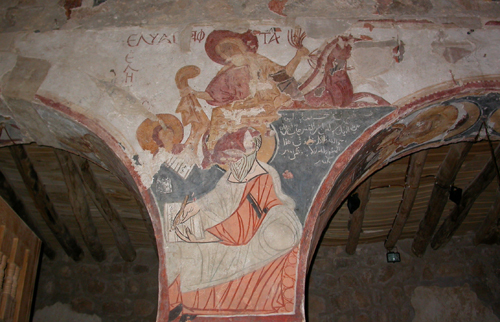![]() Robert B. J. Mason
Robert B. J. Mason
Near and Middle-Eastern Civilizations (NMC)
University of Toronto
|
Near and Middle-Eastern Civilizations (NMC) |
|
University of Toronto - Near and Middle Eastern Civilizations - Mason Home - Unnofficial Mason - Royal Ontario Museum |
|
Frescoes from the church at Deir Mar Musa Medieval wall paintings, and their recreation in the Deir Mar Musa museum
The frescoes in the church at Deir Mar Musa al-Habashi are unique in their extent and preservation. They represent a number of phases. An inscription to mark the restoration of the church is dated to 1058 AD. This is followed by no less than four different levels of frescoes, with the last phase dated to 1192 AD. Image # 1 shows two of the phases. The first phase generally has a white ground, with isolated figures with a pronounced red hue. Here we see Ezekiel on his chariot from the first phase. The composition ends at a straight line along the top because this was the height of the roof at the time. Below this in the image, but above it stratigraphically, is an image of one of the writers of the gospels. This is from the last phase of frescoes, and has a blue field with my vibrant colours in the figures. The inscription to the left gives the date of the final phase of 1192 AD.

1: Section of fresco showing two phases
Image #2 is a general view of the interior of the church. Many of the frescoes appear lost, but in many cases each figure and other part of thye composition is repeated elsewhere. For instance the gospelist from image #1 can be seen here, and behind him, over the following column, is another gospelist. He assumes exactly the same stance, and over the opposing two columns are the other gospelists in exactly the same pose. Above these figure would have been a row of equestrian saints. Image #3 is of one of the equestrian saints. Saint Moses the Abyssinian himself was an equestrian saint, and probably would have been a part of this frieze. This particular saint is probably St. Bacchus, the important Syrian equestrian saint. Once again this is a typical composition, reproduced for centuries afterwards in other representations of equestrian saints, such as icons. Traces of other equestrian saints in the fresco show that they are in exactly the same pose, and there is often enough to indicate who the saint was. For instance a serpent beneath the horse on one figure would be indicative of St. George. The saints on the columns that can bee seen in image #2 are in poor condition, but again elsewhere in the church saints are better preserved. Images #4 and #5 are of two of these perfect saints. They are females, and there are many other female saints in this church, an unusually high proportion, in fact. Typically all of the saints have standardised poses, and it would be possible to recreate the appearrance of even the most fragmentary figure. The final phase of the proposed museum would be to create a full reconstruction of the church, with a reproduction of the last phase of the frescoes.
Deir Mar Musa al-Habashi
|
|
|
University of Toronto - Near and Middle Eastern Civilizations - Mason Home - Unnofficial Mason - Royal Ontario Museum |